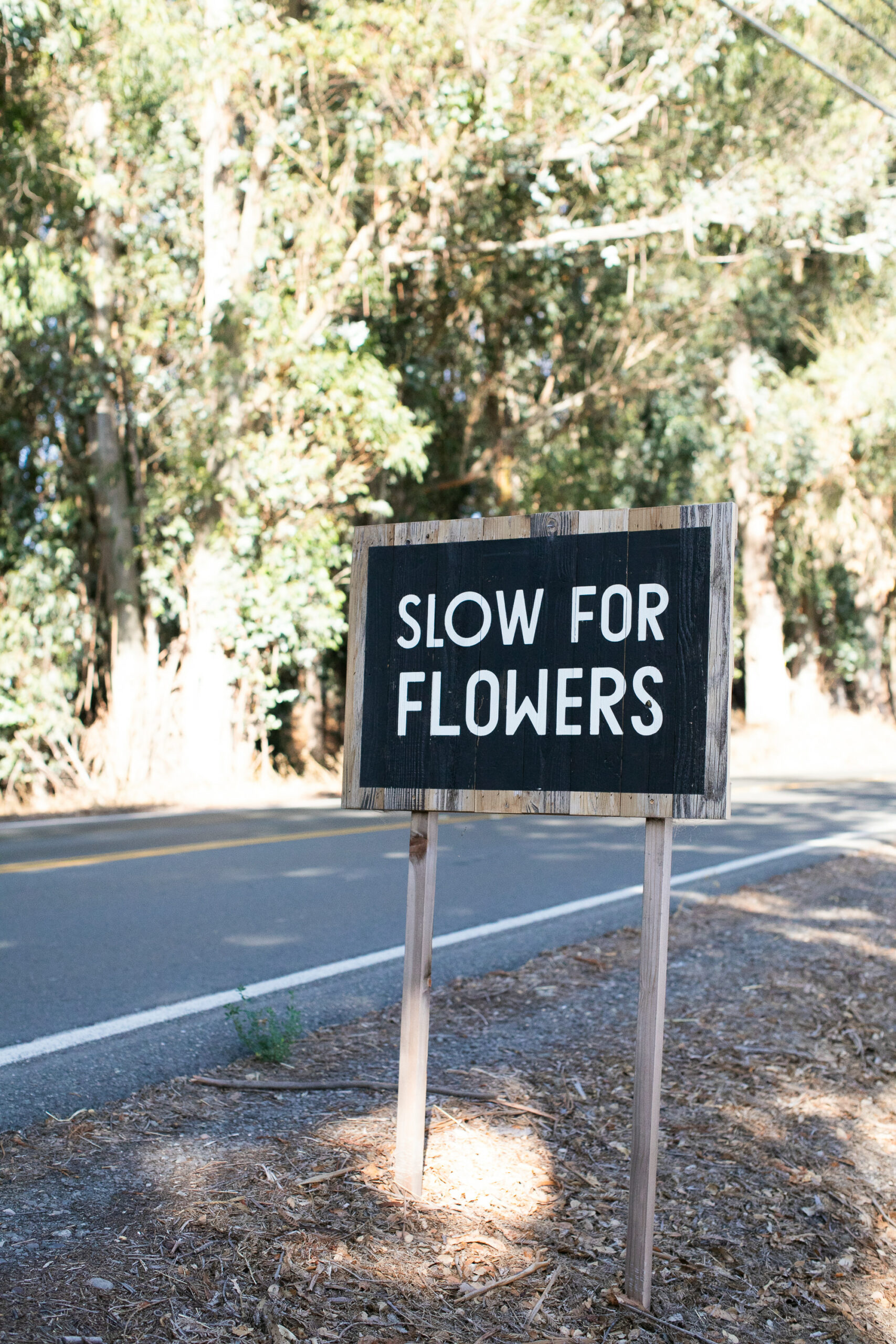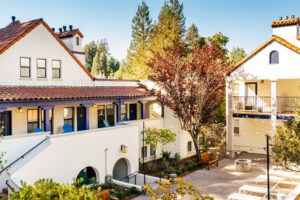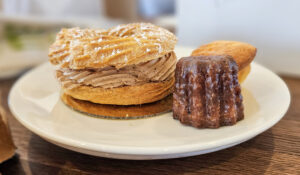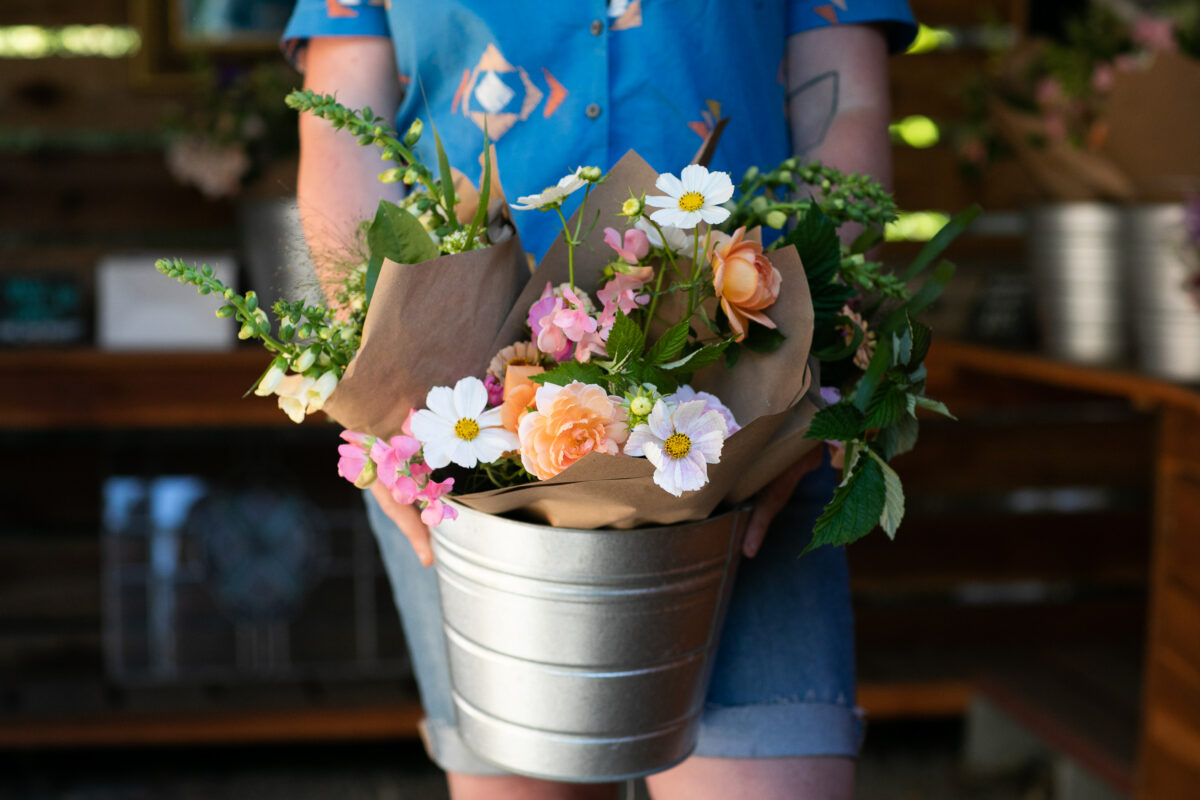Farmer-florist Lennie Larkin says moving into agriculture as a second career was the answer to many questions in her life. “I’d never loved anything like I love flowers; I’d never been so fascinated,” she says. “The cultivation of flowers caused me to slow down and be in the moment more than any- thing I’d ever done. Talk about mindfulness.”
Larkin, who grows an acre of garden roses and other blooms at B-Side Farm in Petaluma, is just one of a group of farmer-florists changing the face of the local specialty cut-flower industry, an industry worth $4 million in 2020. Sonoma’s growers are leaders in advocating for the use of sustainably grown, local flowers—the so-called “farm-to-vase” movement.
Flower lovers, brides, and designers have buckets of options for high-quality blooms grown just a few miles away. “I don’t need a wholesale account at the flower market in San Francisco anymore,” explains Jennifer McClendon, a farmer-florist who creates elegant wedding arrangements at Sebastopol’s JenniFlora. “With the relationships I’ve made here locally, I can source everything I need.”


Sonoma’s farmer-florists are expanding the range of blooms they grow, creating new avenues to support each other’s small businesses. And they are seeing real change in the inclusiveness of the industry as well. “I love the fact that people are so supportive of each other,” says Jude Crawford, who farms with her partner Dale Smith at Zannah Farms in Santa Rosa. “If I have a problem with cucumber beetles on my amaranth, I can reach out to other farmers to figure out what to do.”
Local growers value collaboration and community, explains Zoe Hitchner, who runs the flower program at Healdsburg’s Front Porch Farm, one of the largest farms in the county. She says there’s a feeling of abundance; that there is enough business to go around. “I can say to a client, ‘I can fill half of your order, and I recommend you go to these other growers, too.’”
Days on the farm are exhilarating and creatively fulfilling—but also a constant juggle as growers balance immediate needs with more long-term concerns. “You’re always having all these balls in the air: what you need to do today to get through the day, but also what has to happen to have flowers for sale three months from now,” says Larkin. “If you just put your head down and do the work right in front of you in the field, you’re going to screw up the next season of growing.”
The days start at dawn, as flowers do best when harvested while temperatures are still cool. Then it’s on to sorting and bundling blooms for market, arranging bouquets, prepping for weekend events, customer service, and business calls. Then there’s the constant weeding and field maintenance, much of it done on hands and knees. “Flowers are picky,” says Larkin. “A lot of them need to be corralled or netted or pinched or trained.”
And there’s the treachery of the season, too. Zoe Hitchner at Front Porch Farm has had to adapt her farming plan to broader concerns about drought and fire. It’s common at this time of year to be working and catch a smell of smoke in the air, she says, and during each of the last three years, they’ve been under evacuation warnings. Water—for farming, for local fish and wildlife, and for drinking—is an ever-present concern. The picturesque farm, located in a valley at a bend in the Russian River, draws its irrigation supply from the river, and in 2021, they had to stop irrigating entirely in mid-summer to help keep local water levels sustainable. Hitchner says most of the plants held on to allow them to continue to harvest and supply the market. “This year, we’ve made the choice to farm whatever is possible within the bounds of our year-round team,” she says.


Hitchner and others are mindful of what the local cut-flower industry needs to stay sustain- able, both from an ecological perspective, and from the viewpoint of their own work-life balance. To expand the conversation, Lennie Larkin, shown below, who mentors new farmers and is an officer at the Association of Specialty Cut Flower Growers, is writing a book about the economics of running a cut-flower business, relaying how growers can find out their cost of production or how they can set prices for a fair return on the work hours spent. “It’s about profitability, and that can feel like a dirty word at times,” she explains. “There’s often this sense that farmers should just be in it only for the love of the land.”
And yet a deep love of the land does remain a driving force for these farmer/ designers, who live in tune with the seasons and cultivate their aesthetic sensibilities even as they make their way through chores. “September is an absolutely stunning time on the farm,” says Hitchner. “The weather is just starting to turn, and really interesting clouds build up in the sky and the light changes. Everything feels really dramatic.”
Larkin says she feels the pull of the blooms in the field from the moment she wakes up. “I’ll keep glancing toward the window, just wanting to get out there and walk the fields and see everything—even though I know every flower that’s there, even though I saw them all just yesterday.” Entering the garden in the calm, early morning stillness, when the dew is glistening on the petals and the fields are in their most natural state, is what she calls a perfect moment. “It never fails to lift me up, honestly,” says Larkin. “Something new is happening every day.”


A Sonoma Cutting Garden
Plant beautiful blooms of your own with these farm-tested, designer-approved favorites.
Anemones: Zoe Hitchner calls these “the heroes of spring” for their ability to provide a succession of flowers for up to five months from a single planting. She plants corms the first week of October and covers them in a low tunnel or cold frame. Hitchner recommends planting in moist soil but then waiting to water until shoots emerge—too much water leads to rot.
‘Buddah’s Hand’ Cosmos: Each mature plant boasts dozens of small, tangerine- colored blooms, and the plant will easily naturalize in a cutting garden. Thin seedlings to allow plenty of space, as each will grow to 5 feet tall and wide.
‘Chantilly’ Snapdragons: Lennie Larkin of B-Side Farm says these sweetly fragrant blooms make beautiful “spike flowers” in hand-tied bouquets. She sows them in early spring in pots and transplants into the garden as
young seedlings. When harvesting, cut low for continued blooms.
David Austin Roses: Larkin’s favorite varieties of these chubby, old-fashioned roses include ‘Lady of Shalott,’ ‘Carding Mill,’ and ‘Golden Celebration.’ She recommends planting in the sunniest spot you can find and mulching well. They need lots of water (she suggests using buckets of grey water from the shower) and frequent fertilizing. In Sonoma’s ideal growing climate, Larkin is able to coax up to three rounds of bloom in a single season.


‘Fata Morgana’ Scabiosa: An easy annual that attracts bees and butterflies and has a unique color, somewhere between peach, yellow, and pink. You can sow seeds directly just about any time of year, according to Hitchner. She plants one set of seeds in fall to overwinter into spring, and then starts sowing again in April, planting monthly through the summer.
Mexican Tuberose: These bulbs, native to Mexico and the Southwest, love Sonoma’s hot summer days and bloom prolifically from July until November. Hitchner says they turn up their intoxicating scent at night, attracting the sphinx moth and other pollinators. At Front Porch Farm, they are grown as a perennial, and every four years, the bulbs are dug up, divided, and replanted.
Queen Series Zinnias: Larkin says these are not your grandma’s zinnias, with subtle gradients of color that bring an antique vibe to bouquets. She recommends sowing seeds directly in the garden anytime from April through July. They seem to thrive even when ignored and don’t need rich soil.
‘Sahara’ Rudbeckia: Heat tolerant and in demand from florists for their moody pink and peach coloring, reminiscent of milky coffee. Rudbeckia is technically a perennial, but Hitchner grows it as an annual, starting plants each April from seed in a greenhouse, then transplanting into the field.
And… extra greenery: “The tones, textures, and shapes will elevate home-grown bouquets to the next level,” says Larkin. Some of her favorite greens for Sonoma gardens include lemon basil, silver dollar eucalyptus, and raspberry greens, with or without the berries.
Grown in Sonoma
BEES N BLOOMS/ SIDEKICK FLOWERS
Farmer/florist Seth Gowans leases land at Bees N Blooms and sells his organic flowers alongside Bees N Blooms lavender. Farmstand at 3883 Petaluma Hill Rd., Santa Rosa. 707- 293-8293, beesnblooms.com
DRAGONFLY FLORAL
A longtime favorite, this local farm in the Dry Creek Valley offers local delivery and event design. 707-433- 3739, dragonflyfloral.com
FEATHER FLOWER FARM
Farmer/florist Sierra Bannister sells homegrown flowers at her own small farmstand (email for details) and at Bill’s Farm Basket in Sebastopol. Her Instagram feed (@featherflowerfarm) is stunning. featherflowerfarm.com
FLATBED FARM
A diverse farm and flower operation with a farmstand, farm products, and bouquets for sale from 9 a.m. to 2 p.m. on Saturdays. Farmstand at 13450 Hwy. 12, Glen Ellen. flatbed-farm.com


FRONT PORCH FARM
A 110-acre farm by the Russian River with orchards, vegetables, and wine- grapes in addition to flowers. Flowers are sold at the Saturday farmers market in Healdsburg, to the FEED Sonoma produce hub, and wholesale to local designers. fpfarm.com
FULL BLOOM FLOWER FARM
Owner Hedda Brorstrom grew up in the area and runs a pretty farmstand along a country road, marked by a red mailbox. She also does events and offers weekly flower subscriptions in summer. Farmstand at 9516 Graton Rd., Sebastopol. 707-591-6968, fullbloomflower.com
THE HAPPY DAHLIA FARM
It’s dahlia time right now, and the growing fields are awash in color. A fun place for families to explore together. Farmstand at 2478 E. Washington St., Petaluma. 707-338- 9478, thehappydahliafarm.com
JENNIFLORA
Jennifer McClendon cultivates 1,500 heirloom roses on her 1.5 acre family farm in Sebastopol and designs stun- ning events. Call for bouquet pickup and local delivery. 707-495-9402, jenniflora.com
JOLEE BLOOMS & DESIGN
Owner Daniele Strawn has a diverse design background and runs a quarter-acre farm and a thriving event business in Occidental, with organic bouquets available for pickup or de- livery. 707-775-0101, joleeblooms.com
OAK HILL FARM
This landmark spot in Glen Ellen on over 700 rural acres has been farmed by members of the Teller/Bucklin family since the 1970s. Fresh flowers available at the Sonoma farmers mar- ket on Fridays and at the Red Barn Store farmstand from 9 a.m. to 3 p.m. on Saturdays. 15101 Hwy. 12, Glen Ellen. 707-996-6643, oakhillfarm.net
POPPIES AND PETALS
At this you-pick farm, visitors can design and cut their own bouquet packed with organic, seasonal blooms. Bring your own vase. Open Tues., Thurs., Sat., and Sun. 500 Sanford Rd., Santa Rosa. 707-752- 7891, poppiesandpetalsfarm.com
STRONG ARM FARM
Heidi Herrmann focuses on beautiful tuberoses, primarily for the wholesale market. Herrmann was one of the founders of the North Bay Flower Collective, a local group that pro- motes the local flower movement and supports growers. strongarmfarm.com
SUNRAY FARM
A vegetable and flower farm in Sonoma focused on healthy soils and organic growing practices. They sell flowers at the Petaluma Eastside farmers market on Tuesdays, deliver weekly bouquets, and will sell large flower buckets for DIY arrangements. 707-210-9720, sunrayfarm.com
ZANNAH FARMS
Dale Smith and Jude Crawford cut and arrange fresh bouquets daily for their farmstand, and sell buckets of flowers for DIY arrangements. Farmstand at 5583 Occidental Rd., Santa Rosa. 707-247-5881, zannahfarms.com




















